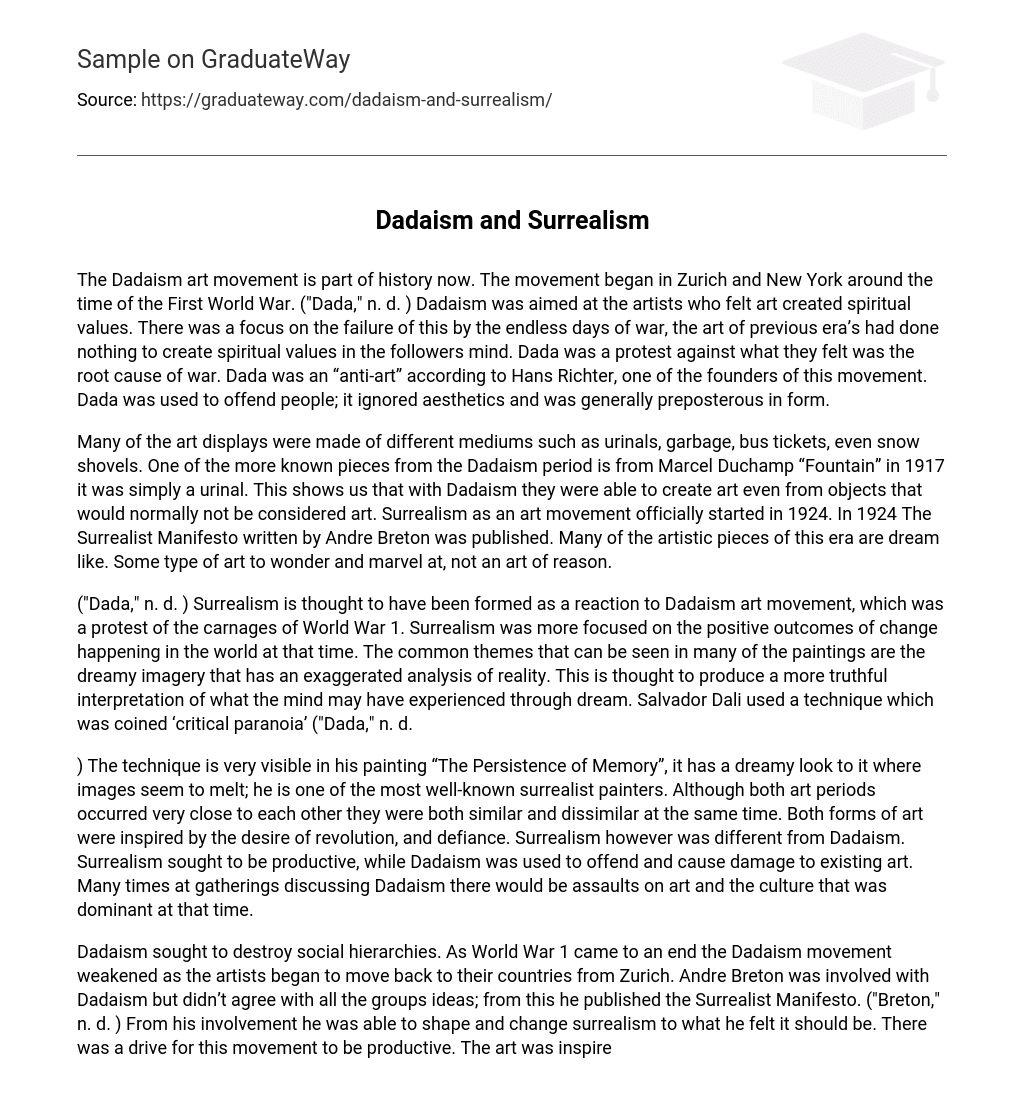The Dadaism art movement, which originated in Zurich and New York during the First World War, is now part of history (“Dada,” n. d.). It aimed to challenge artists who believed that art could create spiritual values. The movement highlighted the failure of previous art forms in instilling such values due to the prolonged period of war. Dada was a response and protest against what they perceived as the underlying cause of war. According to Hans Richter, one of its founders, Dada was an “anti-art” movement that aimed to provoke and offend. Its disregard for aesthetics and its absurdity in form were characteristic of Dadaism.
The art displays included various mediums like urinals, garbage, bus tickets, and snow shovels. One famous piece from the Dadaism period is Marcel Duchamp’s “Fountain” in 1917, which was simply a urinal. This shows how Dadaism allowed artists to turn everyday objects into art. The Surrealism movement started officially in 1924 with Andre Breton’s publication of “The Surrealist Manifesto.” Many artworks from this time have a dream-like quality that encourages viewers to ponder and be amazed instead of relying on logic.
According to (“Dada,” n. d.), Surrealism emerged as a response to the Dadaism art movement, which served as a protest against the devastation caused by World War 1. Unlike Dadaism, Surrealism focused on the positive changes occurring in the world during that period. Many paintings associated with Surrealism exhibit common themes, such as dream-like imagery and an exaggerated analysis of reality. These characteristics aim to provide a more accurate interpretation of the surreal experiences encountered in dreams. One notable artist, Salvador Dali, employed a technique known as ‘critical paranoia’ (“Dada,” n. d.)
The technique of Salvador Dalí’s painting “The Persistence of Memory” is highly visible. It exhibits a dreamy appearance, with images seemingly melting. Dalí is renowned as one of the most well-known surrealist painters. Despite occurring closely in time, both art movements have similarities and differences. Both periods of art were fueled by a longing for revolution and defiance. However, surrealism differed from Dadaism in its aim for productivity, as opposed to Dadaism’s intention to provoke offense and damage existing art. Many gatherings discussing Dadaism involved attacks on art and the dominant culture of that era.
Dadaism aimed at dismantling social hierarchies and declined as World War 1 ended, leading artists to return to their home countries from Zurich. Despite his involvement, Andre Breton disagreed with some of Dadaism’s ideas, which prompted him to publish the Surrealist Manifesto. As a result, he molded and transformed surrealism according to his own vision. This movement emphasized productivity and drew inspiration from psychoanalysis, portraying art in a dreamlike state of limitless possibilities.
Both Dadaism and traditional art aimed to create art that provoked astonishment rather than rationality. Dadaism, similar to Marcel Duchamp’s approach, challenged conventional art by modifying a replica of the Mona Lisa with a colorful mustache and beard. Nonetheless, both artistic periods shared the goal of influencing individuals through the creation and distribution of various journals and manuscripts. These publications sought to articulate their viewpoints on the world while expressing their aspirations for liberating art and culture from societal limitations.
Although they did not have a significant impact on society, both Dali and Duchamp made their mark in the history of art. Their works continue to inspire artists today. In surrealism, Dali’s “Persistence of Memory” and Duchamp’s version of the “Mona Lisa” are notable examples. Both artists embraced revolutionary and defiant elements in their art. Duchamp challenged traditional teachings and norms of the art world, while Dali transformed everyday objects into dreamlike or melting images, as witnessed by certain viewers.
Both of these paintings caused a stir in the art world, as the respective artists were more focused on their own vision than on others’ opinions. They were true revolutionaries, challenging the norms and aligning themselves with their chosen movements. Both artists were resolute in their defiance of traditional art, and these two pieces demonstrate their shared rebellious spirit and other similarities, connecting the two art movements.
Both Dada and surrealism encompassed poets, writers, and visual artists. However, surrealism seemed to have less innovative artists compared to those involved in the dada movement. Both movements produced manuscripts or journals to guide their followers. Dadaism originated from political turmoil, while surrealism emerged from a social revolution. Both forms were fueled by a deep anger towards society.
Surrealism, an artistic movement that expanded upon Dada’s exploration of the subconscious and dreams as a source of inspiration, took it further by incorporating Freud’s deliberate technique to delve into the realm of dreams. This movement had a profound effect on art and culture in the later years of the 20th century. By the late 1970s, surrealism resurfaced under different labels like pop surrealism and neo surrealism because of its impact within the art community. Pop surrealism can be compared to Punk Music or comix.
Surrealism has taught us the importance of appreciating art on a subconscious level, rather than relying solely on visual or literal interpretations. This influence empowers contemporary artists to express themselves freely and easily. Surrealism is widely considered one of the most influential eras in today’s art world, with no other period having such a lasting impact.
References:
Andre Breton. (n.d.). Retrieved April 10, 2013.
Dada / Surrealism. (n.d.). Retrieved from.





